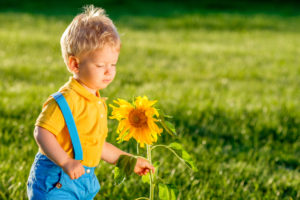
”There are two spiritual dangers in not owning a farm. One is the danger of supposing that breakfast comes from the grocery, and the other that heat comes from the furnace.”
~Aldo Leopold, A Sand County Almanac, 1949
A visit to a toy store in a California beach town uncovered a new product, a mud pie kit. The packaging information offered that the dirt was sterilized, just add water. Plastic bowl, molds and spoons included. Holding this package, selling for 15 dollars, I felt a deep sadness for the child who would use this plaything.
One of my gifts is my clear memories from age two. How many happy hours and afternoons I spent digging in the side yard, making mud creations decorated with leaves, sticks, mulberries and stones, while sitting on a coveted flat rock or brick.
On summer afternoons, the east side of the house would be cool and shaded, populated with rollie-pollies and an occasional June bug. Evenings were spent in the back yard chasing lightning bugs, waiting for the sky to darken enough to see the Milky Way after a vibrant red and purple sunset, serenaded by cicadas. Mornings we were out chasing bumblebees in the clover.
Spring afternoons we discovered the first crocuses, daffodils and tulips, pussy willows, forsythias and my mother’s favorite, asparagus. As we dug under the blossoming plum, the tree hummed with the pollen collection of bees.
Autumn leaves were used to make mountains, forts and jumping piles. I spied the stars from the back of the car, and the Big Dipper seemed to point the way home from my grandparents’ house on winter evenings.
My earliest recollections are of my interaction with nature. These are calm and peaceful memories, the ones I reach for when I seek solace. The sun is as warming as my father’s smile; the wind as caressing as my mother’s brushing my hair.
Richard Louv, in his book Last Child in The Woods: Saving Our Children From Nature Deficit Disorder, shares my concerns about our children’s disconnect from nature through the prevalence of television, air conditioning, computers, video games and our underlying parental fear of ”the bogeyman.” Louv is concerned that we are robbing our children of an essential connection and relationship to the earth. A connection that makes our children feel part of nature, not apart from it. A relationship that creates a sense of joy and wonder. A link that creates curiosity, meaning and context in all of our lives.
In our urban and suburban zoning, children are losing the creative interaction of playing in nature through treehouse building. They are losing the opportunities for creek and wood exploration and being alone–experiences that create confidence, self-reliance and a powerful sense of place. Many schools are shortening or eliminating recess and outdoor time, allowing our children even less interaction with the outdoors.
Twenty minutes of being outside can make the difference between having a good day or a bad day. Connecting to the earth can make the difference between having a joyful life or feeling lost and adrift.
Let’s be creative to find ways to maximize our children’s outdoor experiences. Let’s give them the names of as many plants and animals as possible. Let’s allow them to get dirty and mess up our yards, our parks and our playgrounds a bit with gardening and building exploration. Let’s permit them to stay up to see Orion move over the horizon and command the myths of the sky. Let’s teach them to pay attention to the minutiae of life–the clouds, the wind, the sounds of leaves, the flight of birds.
As Richard Louv writes, ”Passion does not arrive on videotape or on a CD; passion is personal. Passion is lifted from the earth itself by the muddy hands of the young; it travels along grass-stained sleeves to the heart.”


One Response to “The Child in Nature”